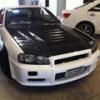R34 Triptronic Controls converted to Audio Controls (THE RIGHT WAY)
Announcements
-
Similar Content
-
Latest Posts
-
By hoodedreeper · Posted
Sorry for resurrecting an oldish thread Not much has happened in the past year since the last update. The car did another 1000 miles or so and failed the MOT for the first time in October (failed on tyres which had been advised for a couple of years) In October the car got put up for sale and was removed in November due to no interest, being so close to christmas it was to be expected. The roads were dry in February so I decided to tax it early and get the new tyres fitted. Fast forward to April, I got someone in to give the car a good clean after sitting for the winter. The car got re-advertised and today (Saturday 3rd May) the car sold. The new owner is planning a GTR conversion at some point and a respray in the same pearl white. It's bitter sweet, it's a shame to have the car sit there for half the year and then only do 1000 miles. The kids are growing too quick and space in the back is getting limited. It's been a great 6.5 years of ownership -
And if you want more power, more reliably, and cheaper, go get the Aussie RB... The 4L Barra and put that in instead.
-
No cats will keep discolouring the rear bar. Sends white paint a weird yellow stain. Cut and polish normally gets it out, but you'll be doing that every fortnight I found.
-
Both heads will be equally reliable or unreliable depending on what you do to them. Stock the RB26 head will flow more. You have access to the stock intake ITB manifold on the RB26 cheaply which flows really well(1000hp+). Arguably more aftermarket support for RB26, though in Aus we love our RB30 SOHC heads too. The only downsides to the RB26 head is if you have a VL commodore and want to keep the SOHC look. Where you may have an issue is drilling out the rb30 block for the bigger head studs but if you are building a big power motor you'd probably put bigger studs on the SOHC head too. This is just about finding a good machine shop, sometimes easier said than done. RB30 head worked can make big power just like a Rb26 head, so really it actually more comes down to what your preference is for your car. People now even making billet versions of both.
-
2630s work perfectly well. There is something to be said for just using the 30 head, as it saves all the pain of the conversion, still makes tons of power, still sounds cool, etc etc. 2630 will obviously make more power again, but the differences are not stupidly big. It really depends on whether you're racing for sheep stations or not. If it's dead serious, then it's a 26 head. If it's just for fun, it could go either way. But the 26 head and the effort to get it set up, etc etc, is part of the fun.
-






Recommended Posts
Create an account or sign in to comment
You need to be a member in order to leave a comment
Create an account
Sign up for a new account in our community. It's easy!
Register a new accountSign in
Already have an account? Sign in here.
Sign In Now